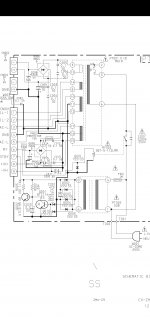Have a transfomer from an old aiwa surround system in perfect condition. Wanted to use it for a project as well as learn from it so I thought I'd ask around. I have attached the schematic for it and just had some questions if anyone could help me learn.
First on the schematic where it showes assembly ground would this be a ground to chassis?
Is it unsafe to leave a rail unused as say if I only needed the postive and ground connection?
Could anyone identify what kind of transfomer this is based on the info provided. From my meauments I get about 43+ , 43- on the VH rails. And then 20+, 20- for the vs rails. Any information or tips would be greatly appreciated.
First on the schematic where it showes assembly ground would this be a ground to chassis?
Is it unsafe to leave a rail unused as say if I only needed the postive and ground connection?
Could anyone identify what kind of transfomer this is based on the info provided. From my meauments I get about 43+ , 43- on the VH rails. And then 20+, 20- for the vs rails. Any information or tips would be greatly appreciated.
Attachments
It appears to link the 0V line of the power supply to chassis via a 0.1uF cap. Such techniques are common in commercial equipment and aimed at reducing interference. There may be a more direct connection elsewhere in the unit.
The - and + VH rails are the high current rails. If you take the DC voltage per rail and divide it by root 2 (1.414) you will get the approximate AC voltage of the transformer.
So -/+ 43 volt means the winding is a 30-0-30 AC one.
It is OK to run with any of the rails unused. Just use what you want.
The main transformer primary is turned on and off via a relay powered by the small Aux transformer. You need to connect '6' to '7' to energise the relay.
The - and + VH rails are the high current rails. If you take the DC voltage per rail and divide it by root 2 (1.414) you will get the approximate AC voltage of the transformer.
So -/+ 43 volt means the winding is a 30-0-30 AC one.
It is OK to run with any of the rails unused. Just use what you want.
The main transformer primary is turned on and off via a relay powered by the small Aux transformer. You need to connect '6' to '7' to energise the relay.
Thank you very much for the detailed reply Mooly I was able to get a tas5630 board i just purchased running with your tip. Another question i have is that the unused rail caps stay charged any advice on how to drain them. I've read about drain resistors but I'm not quite sure how to implement them or should I just remove the unused capacitors???
I wouldn't remove any capacitors.
You could add a 10k 0.5 watt resistor across each of the 3300uF caps. That would discharge them from your 43 volts down to around 8 volts after 1 minute and down to about a 1 volt after 2 minutes. The discharge time is exponential and not linear.
You could add a 10k 0.5 watt resistor across each of the 3300uF caps. That would discharge them from your 43 volts down to around 8 volts after 1 minute and down to about a 1 volt after 2 minutes. The discharge time is exponential and not linear.
